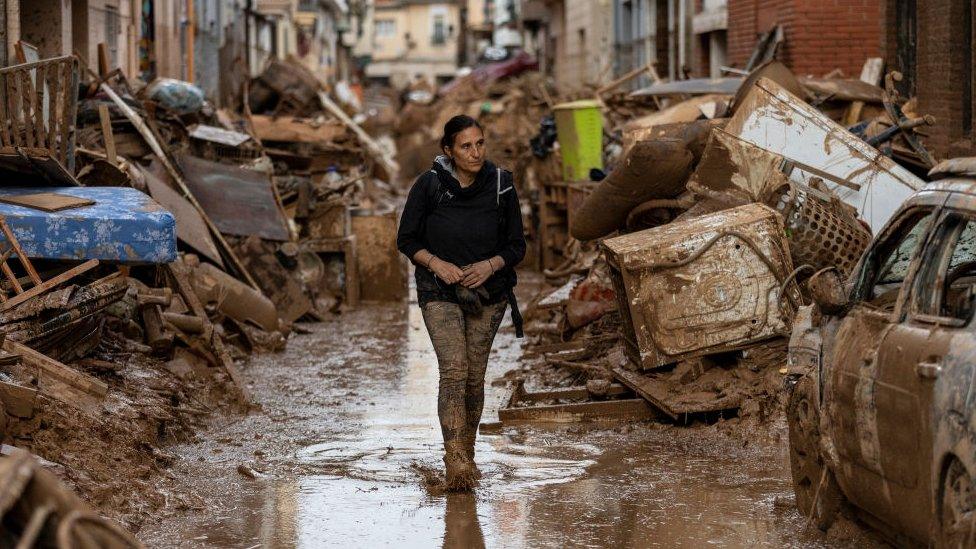South Korea floods: Tunnel horror brings home climate fears
- Published

Rescue workers search for missing people in the flooded underground tunnel following torrential rain
As hundreds of rescue workers comb the muddied waters of a South Korean underpass, the stagnant rainwater, once up to the ceiling, now only covers their knees.
They will not give up. There is one person still missing.
It's been more than 48 hours since extreme rainfall caused a riverbank to break, and water suddenly and forcefully filled the major underpass, stopping vehicles dead.
Thirteen bodies have so far been brought out of the tunnel in the central, mountainous region of Chongju. Rescuers have CCTV footage of a terrified missing driver trying to escape their submerged car, but there is no sign of their body yet.
As they search on, another car is winched out, its back window smashed out by the force of the water.
This scene, akin to one from a horror film, is a wake up call for South Korea. Climate change is starting to take its toll on this country, that until recently has been spared some of the extreme weather events experienced by other, hotter countries.
But only halfway through its monsoon season, and it has already received more than the total amount of rainfall typical for the period.
South Korean President Yoon Suk Yeol has said he will "completely overhaul" the country's approach to extreme weather, as "these events will become more commonplace".
"We must accept climate change is happening, and deal with it," Mr Yoon said.

Song Du-ho tries to process the damage that surrounds him in Edam, a tiny farming village
An hour away, in the tiny farming village of Edam, 87-year-old Song Du-ho sits on his doorstep with his eyes closed as he tries to process the damage that surrounds him.
Inside his modest one-story home, the floors have been ripped up and his waterlogged belongings are stacked up to the ceiling.
Much of what he owns now litters his garden including broken bookcases and electrical appliances. Two soldiers are breaking them down into pieces so they can dispose of them using a wheelbarrow.
Mr Song jumps up. "Hey! Don't throw away the metal, I'm going to sell the metal, throw away the rest," he shouts at them.
The rice and bean farmer's home was flooded after Saturday's torrential rain overwhelmed the dam that normally protects his rural village in North Chungcheong province, in South Korea.
The water was up to his waist by the time rescue workers came for him in the middle of the night, along with his wife, who struggles with a bad back.
"I would be lying if I said I wasn't scared when the water was coming in. I could have died," he says.
Mr Song is dazed. He's lived in Edam for 40 years, and says he is well acclimatised to South Korea's monsoon season, which runs from the end of June to the beginning of August.
But he says he has never experienced rain like that which fell this weekend, causing rivers to swell and land to slide down the dense mountainous terrain, burying homes and killing dozens.
Mr Song knows it will take an awful lot of work to fix his place up, and it is probably beyond his capabilities.
"I'm almost 90," he says in despair. "What am I to do, where am I to go? We older people die where we live."

Han Chang Rae washes her mud-caked belongings with water
Next door, 74-year old Han Chang Rae is squatting in the middle of her mud filled courtyard, dumping the contents of her now defunct fridge into bin bags. Even the mounds of kimchi and other pickled vegetables cannot be saved on this baking, humid day.
Her chequered visor prevents the sweat from dripping down her face, as she motors around, barely taking the time to look up. "I have so much to do," she says in anguish.
In contrast to Mr Song, Ms Han only moved in 15 days ago, and is now binning belongings that never made it out of the box.
She too is bewildered. "I'm 74 and have never experienced this kind of disaster", she says.
"I don't know what to feel, I feel nothing, I'm just lucky I didn't die."
South Koreans are less used to dealing with the effects of the warming planet, and with more extreme rainfall forecast for Tuesday, danger still looms.
For those in the farming village of Edam, the monsoon season is now no longer a routine part of summer, but something to fear.
Related topics
- Published17 July 2023

- Published14 July 2023

